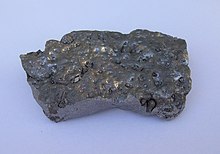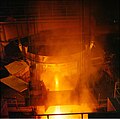User:Rfassbind/sandbox/Siliconproduction
Rewrite of section Silicon#Production in article Silicon.
- Revised structure - sequential
- Extending content (PV)
- Context & comprehension & update
Production
[edit]| Country | 2009 | 2013 | ||||||
|---|---|---|---|---|---|---|---|---|
| Bhutan(B) | n.a. | 61 | ||||||
| Brazil | 224 | 230 | ||||||
| Canada | 53 | 35 | ||||||
| China | 4310 | 5100 | ||||||
| France | 66 | 170 | ||||||
| Iceland | 81 | 80 | ||||||
| India(B) | 59 | 70 | ||||||
| Norway | 301 | 175 | ||||||
| Russia | 537 | 700 | ||||||
| South Africa | 116 | 130 | ||||||
| Ukraine(B) | 98 | 78 | ||||||
| United States | 139 | 360 | ||||||
| Venezuela(B) | 54 | 60 | ||||||
| Other countries | 266 | 430 | ||||||
| World total(i) | 6,310 | 7,700 | ||||||
| Source: minerals.usgs.gov 2013, 2009 Ferrosilicon grades include the two standard grades of ferrosilicon50% and 75% siliconplus miscellaneous silicon alloys, (ii) rounded | ||||||||
Intro overview silicon.
- Silica
- Quarzite
- Tbl worldproduction, top 10 only, 2013 only. No flagspam?
- from silica to ferrosilicon, MG-Si, SoG and UMG-Si to EG-Si. Then semiconductor and solar cell?
Ferrosilicon grade
[edit]
Ferrosilicon, an iron-silicon alloy that contains varying ratios of elemental silicon and iron, accounts for about 80% of the world's production of elemental silicon, with China, the leading supplier of elemental silicon, providing 4.6 million tonnes (or 2/3 of the world output) of silicon, most of which is in the form of ferrosilicon. It is followed by Russia (610,000 t), Norway (330,000 t), Brazil (240,000 t) and the United States (170,000 t).[1] Ferrosilicon is primarily used by the steel industry (see below).
Aluminium-silicon alloys (called silumin alloys) are heavily used in the aluminium alloy casting industry, where silicon is the single most important additive to aluminium to improve its casting properties. Since cast aluminium is widely used in the automobile industry, this use of silicon is thus the single largest industrial use (about 55% of the total) of "metallurgical grade" pure silicon (as this purified silicon is added to pure aluminium, whereas ferrosilicon is never purified before being added to steel).[2]
Metallurgical grade
[edit]

Elemental silicon not alloyed with significant quantities of other elements, and usually > 95%, is often referred to loosely as silicon metal. It makes up about 20% of the world total elemental silicon production, with less than 1 to 2% of total elemental silicon (5–10% of metallurgical grade silicon) ever purified to higher grades for use in electronics. Metallurgical grade silicon is commercially prepared by the reaction of high-purity silica with wood, charcoal, and coal in an electric arc furnace using carbon electrodes. At temperatures over 1,900 °C (3,450 °F), the carbon in the aforementioned materials and the silicon undergo the chemical reaction SiO2 + 2 C → Si + 2 CO. Liquid silicon collects in the bottom of the furnace, which is then drained and cooled. The silicon produced in this manner is called metallurgical grade silicon and is at least 98% pure. Using this method, silicon carbide (SiC) may also form from an excess of carbon in one or both of the following ways: SiO2 + C → SiO + CO or SiO + 2 C → SiC + CO. However, provided the concentration of SiO2 is kept high, the silicon carbide can be eliminated by the chemical reaction 2 SiC + SiO2 → 3 Si + 2 CO.
As noted above, metallurgical grade silicon "metal" has its primary use in the aluminium casting industry to make aluminium-silicon alloy parts. The remainder (about 45%) is used by the chemical industry, where it is primarily employed to make fumed silica, with the rest used in production of other fine chemicals such as silanes and some types of silicones.[3]
As of September 2008, metallurgical grade silicon costs about US$1.45 per pound ($3.20/kg),[4] up from $0.77 per pound ($1.70/kg) in 2005.[5]
Solar grade
[edit]Solar grade silicon cannot be used for microelectronics. To properly control the quantum mechanical properties, the purity of the silicon must be very high. Bulk silicon wafers used at the beginning of the integrated circuit making process must first be refined to a purity of 99.9999999% often referred to as "9N" for "9 nines", a process which requires repeated applications of refining technology.
- Upgrades metallurical grade
Electronic grade
[edit]The use of silicon in semiconductor devices demands a much greater purity than afforded by metallurgical grade silicon. Very pure silicon (>99.9%) can be extracted directly from solid silica or other silicon compounds by molten salt electrolysis.[6][7] This method, known as early as 1854[8] (see also FFC Cambridge process), has the potential to directly produce solar-grade silicon without any carbon dioxide emission at much lower energy consumption.
- Polysilicon
Early purification techniques
[edit]Early silicon purification techniques were based on the fact that if silicon is melted and re-solidified, the last parts of the mass to solidify contain most of the impurities. The earliest method of silicon purification, first described in 1919 and used on a limited basis to make radar components during World War II, involved crushing metallurgical grade silicon and then partially dissolving the silicon powder in an acid. When crushed, the silicon cracked so that the weaker impurity-rich regions were on the outside of the resulting grains of silicon. As a result, the impurity-rich silicon was the first to be dissolved when treated with acid, leaving behind a more pure product.
In zone melting, also called zone refining, the first silicon purification method to be widely used industrially, rods of metallurgical grade silicon are heated to melt at one end. Then, the heater is slowly moved down the length of the rod, keeping a small length of the rod molten as the silicon cools and re-solidifies behind it. Since most impurities tend to remain in the molten region rather than re-solidify, when the process is complete, most of the impurities in the rod will have been moved into the end that was the last to be melted. This end is then cut off and discarded, and the process repeated if a still higher purity is desired.[9]

Modern purification techniques
[edit]Today's purification processes involve the conversion of silicon into volatile liquids, such as trichlorosilane (HSiCl3) and silicon tetrachloride (SiCl4) or into the gaseous silane (SiH4). These compounds are then separated by a distillation and transformed into high-purity silicon, either by a redox reaction or by chemical decomposition at high temperatures.
In the late 1950s, the American chemical company DuPont patented a method for the production of 99.99% pure silicon, using the metal zinc as a reductant to transform redistilled silicon tetrachloride into high-purity silicon by a vapor phase reaction at 900 °C. This technique, however, was plagued with practical problems, as the byproduct zinc chloride (ZnCl2) solidified and clogged lines, and was eventually abandoned in favor of more sophisticated processes.[10]

The best known technique is the so-called Siemens process. This technique does not require a reductant such as zinc, as it grows high-purity silicon crystallites directly on the surface of (pre-existing) pure silicon seed rods by a chemical decomposition that takes place when the gasous trichlorosilane is blown over the rod's surface at 1150 °C. This and similar processes produce polycrystalline silicon at typically 9N–11N purities, that is, it contains impurity levels of less than one part per billion (ppb).[11][12][13]
In 2006 REC announced construction of a plant based on fluidized bed (FB) technology using silane: 3 SiCl4 + Si + 2 H2 → 4 HSiCl3, 4 HSiCl3 → 3 SiCl4 + SiH4, SiH4 → Si + 2 H2.[14] The advantage of fluid bed technology is that processes can be run continuously, yielding higher yields than Siemens process, which is a batch process. Other precursors such as tribromosilane had been used as well.

Recrystallization / Monocrystalline silicon
[edit]The majority of silicon crystals grown for device production are produced by the Czochralski process, (CZ-Si) It was the cheapest method available. However, single crystals grown by the Czochralski process contain impurities because the crucible containing the melt often dissolves. Historically, a number of methods have been used to produce ultra-high-purity silicon.
Structure
[edit]Sequence of processes in chronological order
- Intro paragraph
- base materials description silica, quarzite
- significance, which industries
- wikitable worldwide silicon production (Y2006 and Y2013) by country
- explain- all about purification and why.
- wikitable listing all GRADES of Si, with N-scale, energy consumption, alternative names, remarks-col?
- Ferrosilicon - "Ferrosilicon grade" silicon
- How does 'elemental silicon - silicon metal fit into structure?
- MG-Si, Metallurical grade silicon
- needs process description of carbothermic reaction
- image of a EAF (photo or schematic?)
- Solar grade silicon
- context
- UGM silicon
- short version only - extended version best in new section "production" of article crystalline silicon
- share (siemens) polysilicon, FBR and UMG in solar market?
- EG Silicon - Electronic grade
- alternative name semiconductor silicon
- extend Siemens process as it deserves more attention. Pro and cons (contrasting to FBR). Quantities.
- FBR - more generic - (not only REC). Market share current/expected (IHS report)
- chronology - recrystallisation process AFTER polysilicon production
Articles to pay attention - to link, for consistency, to amend
- Metallurgical
- polysilicon / polycrystalline silicon
- Bridgman–Stockbarger technique - both mono/poly
- Siemsprocess
- monocrystalline silicon
In addition:
- Image candidates
-
PolysiliconNitol
Assimilated content
[edit]Article list
References
[edit]- ^ "Silicon Commodities Report 2011" (PDF). USGS. Retrieved 2011-10-20.
- ^ Apelian, D. (2009) Aluminum Cast Alloys: Enabling Tools for Improved Performance. North American Die Casting Association, Wheeling, Illinois.
- ^ Cite error: The named reference
USGSwas invoked but never defined (see the help page). - ^ "Metallurgical silicon could become a rare commodity – just how quickly that happens depends to a certain extent on the current financial crisis". Photon International. Retrieved 2009-03-04. [dead link]
- ^ "Silicon" (PDF). usgs.gov. Retrieved 2008-02-20.
- ^ Rao, Gopalakrishna M. (1980). "Electrowinning of Silicon from K2SiF6-Molten Fluoride Systems". Journal of the Electrochemical Society. 127 (9): 1940. doi:10.1149/1.2130041.
- ^ De Mattei, Robert C. (1981). "Electrodeposition of Silicon at Temperatures above Its Melting Point". Journal of the Electrochemical Society. 128 (8): 1712. doi:10.1149/1.2127716.
- ^ Deville, H. St. C. (1854). "Recherches sur les métaux, et en particulier sur l'aluminium et sur une nouvelle forme du silicium". Ann. Chim. Phys. 43: 31.
- ^ Siffert, Paul; Krimmel, E. F (2004). Silicon: Evolution and future of a technology. p. 33. ISBN 978-3-540-40546-7.
- ^ Google.com - Patents Production of silicon - Publication number US2909411 A
- ^ Yasuda, Kouji; Saegusa, Kunio; Okabe, Toru H. (2010). "Production of Solar-grade Silicon by Halidothermic Reduction of Silicon Tetrachloride". Metallurgical and Materials Transactions B. 42: 37. Bibcode:2011MMTB...42...37Y. doi:10.1007/s11663-010-9440-y.
- ^ Yasuda, Kouji; Okabe, Toru H. (2010). "Solar-grade silicon production by metallothermic reduction". JOM. 62 (12): 94. Bibcode:2010JOM....62l..94Y. doi:10.1007/s11837-010-0190-8.
- ^ Van Der Linden, P. C.; De Jonge, J. (2010). "The preparation of pure silicon". Recueil des Travaux Chimiques des Pays-Bas. 78 (12): 962. doi:10.1002/recl.19590781204.
- ^ "Analyst silicon field trip" (PDF). hugin.info. March 28, 2007. Retrieved 2008-02-20.


